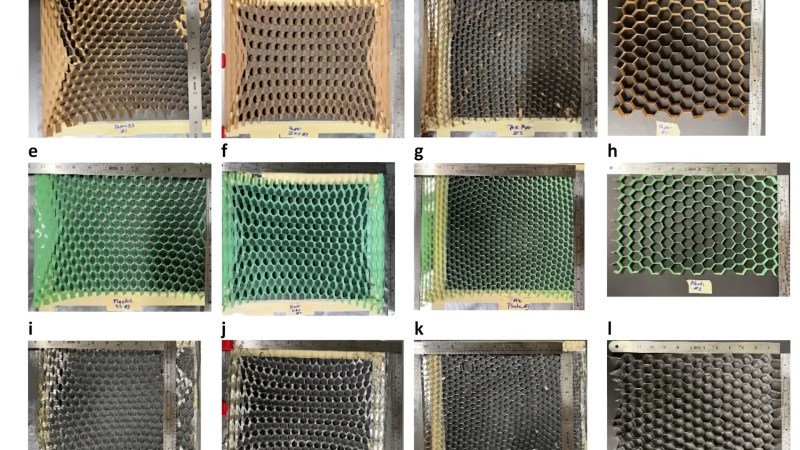You may not think much of origami or its cousin-with-cutouts kirigami, but the latter could (and already is) helping to save the planet. But let’s back up a bit.
Most readers will be familiar with origami, the Japanese art of folding paper. But there is also kirigami, which uses a series of cuts to produce 3D shapes from 2D stock. Turns out that if you cut paper just right, you can turn it into highly-recyclable packaging that even interlocks with itself, negating the need for folding or even tape.
 The video after the break takes a look at 3M’s Scotch Cushion Lock™ protective wrap through the eyes of its inventor, Tom Corrigan. It all started when 3M wanted to create a self-assembling box from a flat piece of cardboard.
The video after the break takes a look at 3M’s Scotch Cushion Lock™ protective wrap through the eyes of its inventor, Tom Corrigan. It all started when 3M wanted to create a self-assembling box from a flat piece of cardboard.
So far, that particular invention hasn’t come to fruition, but after many long nights with paper and X-Acto knives, Tom came up with a honeycomb design with strong vertical walls that absorb energy much like bubble wrap or packing peanuts. The toothiness of each honeycomb wall adds height which adds strength, and allows the packaging to interlock with itself.
Not only is this packaging easier to recycle, it takes up way less space than other packaging alternatives. Once expanded, a 1,000 square foot roll of this stuff is equal to 2,500 square feet of bubble wrap, which constitutes about a dozen rolls.
Now, what to do about all that expanded polystyrene packaging still out there? With the right tool, you can turn it into insulation.
Thanks to [Keith Olson] for the tip!

















As always, this will only be adopted if it’s the cheaper option. Amazon already abandoned all of it’s climate commitments.
There’s a case to be made that if you take the manufacturing process into account, the cheapest option is often also the most environmentally friendly. It’s obviously not a perfect metric, as the micro plastic plague demonstrates.
Is anybody with any credibility making that case?
Regardless, the cheapest, most environmentally friendly option is to stop wasting time, money and other resources on unnecessary, disposable junk. That’s not a very profitable message, which probaby explains why we don’t hear it enough.
I’m sure plenty of places out there that make the premium products that are supposed to last are making profit with it… The real problem isn’t that its not profitable but that because we can make cheap more disposable versions of everything these cheap devices are being bought by the people that can’t easily save to buy the one that will last and be way cheaper in the long run. Or by the folks that don’t really need to own this tool at all, but its cheaper to buy a cheap one than try to find somewhere to rent it for the weekend…
And there certainly is a bit of a case for Jonathan’s statement – as manufacturing costs have to factor in the power costs to run the production line, the shipping costs for the the more raw materials etc – many of the important costs that go into making a product can (NOTE not always) be cheaper with the more ecofriendly options.
So in the case of this paper packaging I’d suggest it should work out massively cheaper – the raw material is any old and doesn’t even have to be high grade recycled paper pulp, so very available and cheap, and the volume it takes up before you deploy it is almost nothing in comparison to other packing materials, so it should be cheap to ship. The only way this looks like it might fail is if it doesn’t provide enough protection so you get more goods damaged in shipping and those costs out weigh the saving.
I have friend that wrote their thesis on Paper vs Plastic. End result was due to weight and stack density which change shipping, plastic won out as better for the environment. Obviously reusable is the best.
But yes there are plenty of creditable papers that back the case.
It does not take into account changes in technology where manufacturing has not caught up.
>There’s a case to be made that if you take the manufacturing process into account, the cheapest option is often also the most environmentally friendly.
No, there isn’t any such case. In fact, it’s usually the most expensive option.
https://en.wikipedia.org/wiki/Jevons_paradox
This would only be true if companies internalize all external costs. Which is literally the point of regulations.
Regulations are / will be there to push commitments into reality.
Which usually means of course … more cost… which we all then complain about. Or until we just get regulated to death… and then we won’t care… only the happy bureaucrats will love it.
“Which usually means of course … more cost…” pushed back to the producer, instead of externalized. Manufacturers profit from making plastic, everyone on Earth pays the consequences of environmental degradation.
All things cost what they cost. It’s just a question of how we want to apportion it.
Creating an environmental disaster is cheap and easy. Cleaning up is hard and expensive. Absent sufficient regulation, we get too many of ’em. Making the people who would otherwise create the externality pay for it gets you back to the “optimal” amount of damage to the environment. It’s Econ 201 or so.
Walmart uses it on things like canned goods.
Not true, Amazon is doing a lot of stuff in it’s packing to preserve the environment. I hate to say good things about them, but I actually see this in the warehouse I work in for them. We switched to reusable carts instead of wood pallets and when we use pallets they are plastic inner company pallets (reusable). Also, we switched to paper stuffing in the packages and the envelopes are now paper as well. So you are a bit out dated on your view.
The carts are likely the result of rising wood costs. Pallets are still king here, but they get destroyed. Anything with plastic in it, right now, is considered horrible. I honestly could care less, plastic is wonderful stuff. We need to work harder on recycling it. Charge people who get caught dumping it. Find ways to repurpose what’s been made, and work towards efficient reworking of plastics already out there. One of the worst things that we did was make packaging items out of plastic, including bags. There are lots of great ways to repurpose that stuff, like melting it down into bricks or planks to build bench seats. Don’t like the weird color? Paint it. Or you could powder coat it, melting a thin layer of plastic over the bricks to hide the recycled materials.
Sorry, I got off on a rant.
Save the planet by mandating Washington and Hollywood ELITES fly commercial – like everyone else!
Welp, there goes your social credit score.
Make ’em walk… through the real world.
Emissions and plastic waste are separate issues. But you knew that, didn’t you.
I replaced a bunch of cameras at a Fedex hub and they had a machine that makes this stuff out of cardboard. I had to pack up the old ones and made some myself. It turned out to be much easier to just rip up the foam from the new cameras. It was a flat rate job, and time is money……
This is old news. Machines that make such filler material from (waste) paper or cardboard have been around for decades. Often used in b2b scenarios to pack heavier parts and replaced wood wool.
I agree. Like that “invisibility cloak film”, which also has been ubiquitous for decades, I have no idea why this stuff is also becoming a “new” attention trend, and why so many people are oblivious to such common things. I wonder how many other human inventions can/will be thrusted into the spotlight as “new innovations”?…
I think I’ve seen similar packaging used by DigiKey
I remember that too. Given the volume handled by players like Digi-Key, this looks like scaling quite much.
Digikey has used this stuff pretty much exclusively for many years. I get regular boxes from them, several a month.
Now if you can get Digikey to use fewer plastic zip lock bags! I just got an order where every encoder was hand wrapped into in a separate zip-lock bag. Any these are not even electronic, just a mechanical switch. Why they double bag a lot of parts is mystifying to me. One thing… I never have to buy zip-lock bags for the shop.
Yeah, those Digikey bags are great. Nice and tough…. it’s like a food chain, you buy stuff from Digikey, assemble a widget, then reuse Digikey’s packaging to send the completed widget to your client.
The concept is not new at all, I see such packaging stuff very often, and this for many years!
I’ve been using something similar for over a decade, also by Scotch. It’s basically improperly shredded heavy paper made from recycled cardboard.
Hundreds of little divots (not true holes) where the “chads” catch the holes opposite them.
You can make your own if you have a sizeable shredder by running cardboard sheets through a mis-aligned feed.
also works with paperboard and $25 shredders. Think frozen food boxes.
If I need something heavy duty I buy a roll. For most shipping I just make my own. The recipient still Recycles the paper packing and the box gets one extra life before recycling.
“Buy less stuff” doesn’t contribute to corporate profit, decreases waste, and has the benefit of keeping money in MY pocket instead of Amazon et al’s shareholders.
The only trouble is, frugality just isn’t sexy. Solve that problem and you will save the planet.